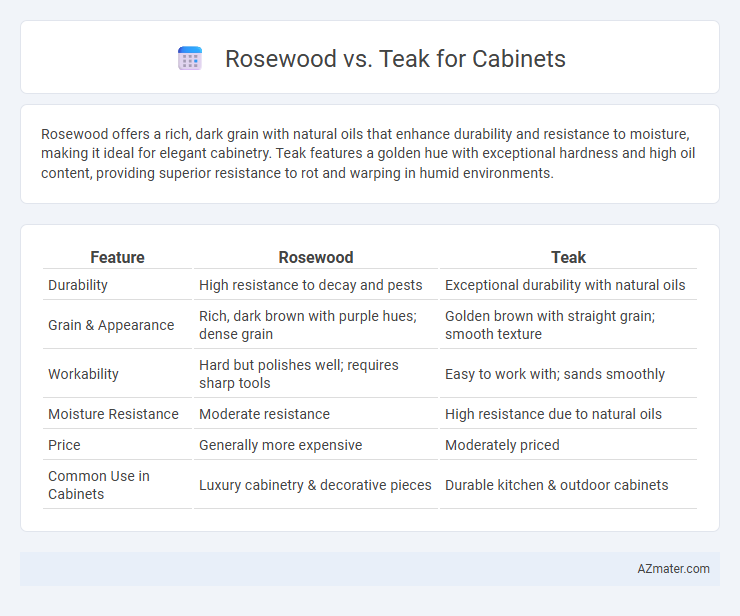Rosewood offers a rich, dark grain with natural oils that enhance durability and resistance to moisture, making it ideal for elegant cabinetry. Teak features a golden hue with exceptional hardness and high oil content, providing superior resistance to rot and warping in humid environments.
Table of Comparison
| Feature | Rosewood | Teak |
|---|---|---|
| Durability | High resistance to decay and pests | Exceptional durability with natural oils |
| Grain & Appearance | Rich, dark brown with purple hues; dense grain | Golden brown with straight grain; smooth texture |
| Workability | Hard but polishes well; requires sharp tools | Easy to work with; sands smoothly |
| Moisture Resistance | Moderate resistance | High resistance due to natural oils |
| Price | Generally more expensive | Moderately priced |
| Common Use in Cabinets | Luxury cabinetry & decorative pieces | Durable kitchen & outdoor cabinets |
Introduction: Rosewood vs Teak Cabinets
Rosewood and teak are premium hardwoods highly valued for cabinet construction due to their durability and aesthetic appeal. Rosewood features rich, dark hues with distinctive grain patterns, offering a luxurious, elegant look for cabinetry. Teak is renowned for its natural oils that provide exceptional resistance to moisture and pests, making it ideal for highly durable, long-lasting cabinets.
Appearance and Grain Patterns
Rosewood cabinets showcase rich, dark hues ranging from deep browns to purples with striking, complex grain patterns featuring natural swirls and veins that add a luxurious and exotic character. Teak cabinets exhibit warm golden to medium brown tones with straight, even grains interspersed with occasional wavy patterns, emphasizing a smooth, consistent texture ideal for classic or modern designs. The visual contrast between rosewood's dramatic elegance and teak's subtle warmth makes both woods desirable for cabinetry depending on the desired aesthetic impact.
Durability and Strength Comparison
Rosewood offers exceptional durability with high natural oils that resist moisture and decay, making it ideal for long-lasting cabinetry. Teak is renowned for its superior strength and resistance to warping, due to its dense grain and high silica content, ensuring structural integrity over time. Both woods provide excellent durability, but teak generally outperforms rosewood in strength, making it preferable for cabinets subjected to heavy use.
Resistance to Moisture and Termites
Rosewood offers moderate resistance to moisture but is more susceptible to termite damage compared to teak, which is highly durable due to its natural oils and dense grain. Teak's exceptional resistance to moisture and termites makes it ideal for cabinets in humid environments or areas prone to pests. Cabinet makers often prefer teak for long-lasting protection against decay and insect infestation.
Maintenance and Care Needs
Rosewood cabinets demand regular polishing and protection from excessive moisture to prevent cracking and maintain their rich color, while teak offers superior natural oil content that resists water and pests, requiring less frequent maintenance. Teak's durability makes it ideal for environments prone to humidity, whereas rosewood may need more vigilant care to avoid staining and fading over time. Both materials benefit from gentle cleaning with a soft cloth and mild soap, but teak's resilience reduces the overall effort needed for long-term upkeep.
Cost and Availability
Rosewood cabinets often command higher prices due to their dense grain, rich color, and limited availability, making them a premium choice in luxury woodworking. Teak, while also a durable hardwood, is generally more affordable and widely available owing to sustainable plantations and quicker growth cycles. Budget-conscious buyers seeking durability may prefer teak, whereas rosewood suits high-end projects requiring unique aesthetics despite its higher cost and limited supply.
Sustainability and Environmental Impact
Rosewood and teak are both popular materials for cabinets, but teak is generally considered more sustainable due to its faster growth rate and availability from well-managed plantations. Rosewood species often face stricter trade regulations under CITES, reflecting concerns about overharvesting and deforestation. Teak's natural resistance to pests and decay reduces the need for chemical treatments, lowering its environmental impact compared to rosewood, which may require more intensive preservation methods.
Common Uses in Cabinetry
Rosewood is prized for its rich color variations and natural oils, making it an excellent choice for decorative cabinet fronts and fine furniture accents that require durability and aesthetic appeal. Teak's high oil content and resistance to moisture make it ideal for kitchen and bathroom cabinets, where longevity and water resistance are essential. Both woods are favored for luxury cabinetry, with rosewood often used in intricate veneers and teak preferred in areas exposed to humidity.
Pros and Cons Summary
Rosewood offers rich color variation and exceptional durability, making cabinets visually striking and long-lasting, but it tends to be more expensive and harder to source sustainably. Teak is highly resistant to moisture and pests, ideal for kitchen cabinets in humid environments, though it has a more uniform appearance and can darken over time. Both woods provide excellent strength and longevity, but cost, aesthetic preference, and environmental impact are key factors in choosing between rosewood and teak for cabinetry.
Which Wood is Best for Your Cabinets?
Rosewood offers a rich, dark grain and high durability, making it ideal for luxurious cabinet finishes, while teak is prized for its natural oils that resist moisture and pests, perfect for kitchens or bathrooms. Rosewood's density and hardness ensure long-lasting wear and a polished appearance, whereas teak's stability in humid environments prevents warping and cracking. Choosing between rosewood and teak depends on your cabinet's location and desired aesthetic, with rosewood favored for elegance and teak recommended for functionality in moisture-prone areas.

Infographic: Rosewood vs Teak for Cabinet
 azmater.com
azmater.com